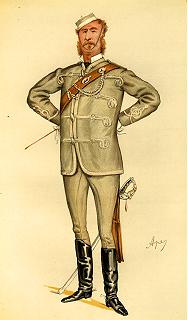Robert William Edis
From Wikipedia, the free encyclopedia
Colonel Sir Robert William Edis KBE CB DL JP (13 June 1839 – 23 June 1927) was a British architect.[1][2]
Colonel Sir Robert William Edis | |
|---|---|
 "Architecture Militant", caricature of Edis by "Spy" (1885) | |
| Born | Robert William Edis 13 June 1839 |
| Died | 23 June 1927 (aged 88) |
| Education | Huntingdon Grammar School Aldenham School |
| Spouse | Elizabeth Ann Woodward |
| Children | 5 |
| Relatives | Isabella Reaney (sister) Olive Edis (niece) |
Early life
Edis was born in Huntingdon to Emma and Robert Edis, also an architect.[3] His sister was the preacher Isabella Reaney,[4] his brother was Arthur Wellesley Edis, a gynaecologist,[5] and his niece through Arthur was the photographer Olive Edis.[6]
Edis was educated at Huntingdon Grammar School and Aldenham School, before attending University College School in London and studying at the Royal Academy Schools.[3] He was then articled to William Gilbee Habershon and Edward Habershon, architects, in London.[1][2]
Career
Summarize
Perspective

He became chief assistant to Anthony Salvin, and joined the Architectural Association in 1859.[1] He was admitted an Associate of the Royal Institute of British Architects in 1862 and a fellow of the association in 1867.[1]
Although his early work was Gothic, Edis later became a proponent of the Queen Anne style of baroque revival architecture. He worked mostly on private houses and public buildings, although he did design a few churches.[7]
He later became involved in the Aesthetic Movement of decorative arts and in furniture design, and delivered a series of Cantor lectures on the subject at the Royal Society of Arts. These formed the basis of two books: Decoration and Furniture of Town Houses (1881) and Healthy Furniture and Decoration (1884).[1][8] Combining principles of Aestheticism with the Sanitary Movement, Edis delivered a lecture during the 1884 International Health Exhibition calling for more artistic designs within hygienic interior objects.[9]

From 1883, Edis extended and rebuilt Sandringham House in Norfolk for the Prince of Wales.[10][11] He was the designer of the parish hall and parsonage for St Philip's Church, Buckingham Palace Road (1892) and the British pavilion at the World's Columbian Exposition in Chicago (1893).[citation needed]
He built a studio on Church Street, Sheringham, for his nieces the photographers Olive and Katharine Edis. It was their first studio and had a glass roof to allow in natural daylight which became an important aspect of their trademark style.[6]
Edis had a long association with the Volunteer Force and its successor the Territorial Force. In 1868 he received a commission in the Artists' Rifles.[12] He went on to be the regiment's commanding officer from 1883 to November 1902,[13][14][15] and subsequently held the office of honorary colonel from 1902 until his death (he continued when the regiment was reorganized as part of the Territorial Force in 1908).[2][16] He designed the unit's drill hall at Duke's Road, off Euston Road, Camden (now The Place, home of the Contemporary Dance Trust).[17]
In January 1889 he was elected a member of the first London County Council, representing St Pancras South for three years as a member of the Conservative-backed Moderate Party.[18]
Personal life
In 1863, Edis married Elizabeth Ann Woodward.[3] He had homes at Ormesby Old Hall, Great Ormesby, Norfolk, as well as Fitzroy Square[19] and Regent's Park, London.[20] He was a justice of the peace and a Deputy Lieutenant for Norfolk from 1901.[2][21] He was created a Knight Commander of the Order of the British Empire in 1919 for his military services.[22]
Edis died suddenly at his Norfolk home in 1927, aged 88.[2] He was predeceased by his wife, but was survived by his five daughters.[23]
References
External links
Wikiwand - on
Seamless Wikipedia browsing. On steroids.
